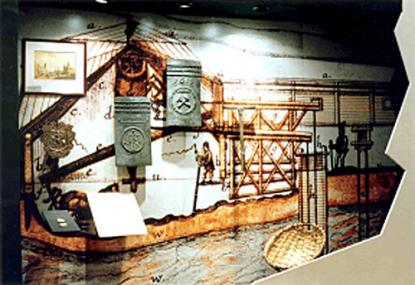2024. November 22. Friday
Central Museum of Mining - Sopron
|
|
Address: 9400, Sopron Templom utca 2.
Phone number: (99) 312-667, (99) 338-902
E-mail: info@kbm.hu
Opening hours: 01.04-31.10.: Tue-Sun 10-18
01.11-31.03.: Tue-Sun 10-16 |
Museum tickets, service costs:
|
Ticket for adults
|
700 HUF
|
|
|
Ticket for students
|
400 HUF
|
|
|
Ticket for pensioners
|
400 HUF
|
|
|
Audio guide
|
200 HUF
|
|
|
Audio guide
(in German)
|
200 HUF
|
The easily cleaving flint was mined in the Carpathian Basin 40-50000 thousand years ago. The most important findings in connection with flints from the Neolith Age are from Mogyorósdomb, the Avas of Miskolc, and the Kálváriadomb of Tata.

The findings (castings, arrow heads, and axes) of the excavations performed in Velem Szent Vid betray that the Bronze Age had already developed a system to process metal.
The Roman Empire mined noble ore in Transylvania from 107 BC. The center of the gold mines was Zalatna/Ampelum, and the center for processing it was in Verespatak/Alburnus/Maior.
The noble metal mining of Hungary was significant in the 16th century in Europe. The first miners came with Queen Giselle. After the Tartars left the rebuilding process was performed by the help of German miners, the settlements where they lived was announced towns by Béla IV.
At the beginning of the Middle Ages our salt mines were significant, it took 10 % of the income of the King.
The first law in connection with the mines came from Károly Róbert. In 1486 King Matthias reinforced the privileges of the mining towns and erased the tax on the part of these towns.
The Associating of the Mining Towns of Lower Hungary was founded in 1380, the same association in Upper Hungary was founded in 1487. Their characteristic feature was the so called mine coin, which were accepted only in the town of their deflation.
The center of the gold mines in Transylvania was the Ore Mountain from 1301 until 1550. These areas were occupied by mines at the period of the Romans as well. However, the most important mines were the salt mines.
The ore mining in Hungary became very important again in the 18th century. In Selmecbánya 40 000 kg of silver was mined every year. Following this period the mining of iron and coal became important, which were more abundant by the mid 19th century. The first coal mine was next to Sopron, in Brennbergbánya.
The Hungarian coal mining was turned to have a symbolic interest by the politicians of the period after WWII. The results of this industry and discoveries of it were very significant at the end of the 20th century. From 1990 our mining system changed in its basis, most of the mines were closed just like the mine of Visonta, which was supporting the functioning of the Mátrai Thermal Power Station.

The findings (castings, arrow heads, and axes) of the excavations performed in Velem Szent Vid betray that the Bronze Age had already developed a system to process metal.
The Roman Empire mined noble ore in Transylvania from 107 BC. The center of the gold mines was Zalatna/Ampelum, and the center for processing it was in Verespatak/Alburnus/Maior.
The noble metal mining of Hungary was significant in the 16th century in Europe. The first miners came with Queen Giselle. After the Tartars left the rebuilding process was performed by the help of German miners, the settlements where they lived was announced towns by Béla IV.
At the beginning of the Middle Ages our salt mines were significant, it took 10 % of the income of the King.
The first law in connection with the mines came from Károly Róbert. In 1486 King Matthias reinforced the privileges of the mining towns and erased the tax on the part of these towns.
The Associating of the Mining Towns of Lower Hungary was founded in 1380, the same association in Upper Hungary was founded in 1487. Their characteristic feature was the so called mine coin, which were accepted only in the town of their deflation.
The center of the gold mines in Transylvania was the Ore Mountain from 1301 until 1550. These areas were occupied by mines at the period of the Romans as well. However, the most important mines were the salt mines.
The ore mining in Hungary became very important again in the 18th century. In Selmecbánya 40 000 kg of silver was mined every year. Following this period the mining of iron and coal became important, which were more abundant by the mid 19th century. The first coal mine was next to Sopron, in Brennbergbánya.
The Hungarian coal mining was turned to have a symbolic interest by the politicians of the period after WWII. The results of this industry and discoveries of it were very significant at the end of the 20th century. From 1990 our mining system changed in its basis, most of the mines were closed just like the mine of Visonta, which was supporting the functioning of the Mátrai Thermal Power Station.
